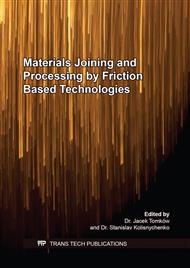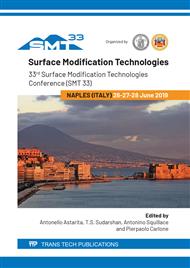p.370
p.376
p.381
p.387
p.393
p.399
p.404
p.411
p.417
Stationary Shoulder Friction Stir Processing: Influence of Tool Wear on Surface Properties
Abstract:
In the present study, the influence of stationary shoulder friction stir processing (SSFSP) tool wear on the processed surface was investigated. SSFSP is a solid-state process that uses a rotating tool plunged in the material to promote microstructure modification, mainly grain refinement, on the workpiece without melting the material itself. It differs from conventional Friction Stir Processing (FSP) since in the SSFSP the tool shoulder does not rotate and simply slides on the surface. The workpiece processed with SSFSP shows a smoother surface without shoulder marks, and with smaller flash than conventional FSP. The tool wear could slightly change the profile of the shoulder and affects process soundness. SSFSP testing made up of 2880 experiments, each one with a path length of 50 mm, was realized on AA 6082 T6 sheets with 3.0 mm thickness using 1500 rpm tool rotation speed and 300 mm/min welding speed. Optical and confocal microscopy analysis and Vickers micro hardness measurements allowed putting in evidence the characteristics of the processed surfaces and their modifications as a function of tool wear.
Info:
Periodical:
Pages:
393-398
Citation:
Online since:
July 2019
Price:
Сopyright:
© 2019 Trans Tech Publications Ltd. All Rights Reserved
Share:
Citation:



